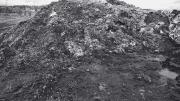In a brilliantly quixotic, scholarly rich, fabulously illustrated trek, Hanna Rose Shell guides readers through the history of the reprocessing of used clothing and textiles, reflecting on human ornament, fears of contagion (think of the associations of “shoddy” versus “virgin” wool), and the evolution of a vast industry. The compact result, Shoddy: From Devil’s Dust to the Renaissance of Rags (University of Chicago, $25), reflects seemingly endless physical and archival legwork by Shell ’99, Ph.D. ’07, JF ’10, now associate professor at the University of Colorado, Boulder. From the vivid prologue:
You can see the heap as you travel between Manchester and Leeds on the M62, the motorway that crosses England’s old industrial region and connects its two great port cities, Liverpool and Hull. It’s hard to tell what it is, though, and most travelers probably pass right by. Reaching about 20 feet at its highest point, the heap could easily be mistaken for an unusual geological formation. From a different angle, it might appear to be a mound of manure but for the fact that’s dappled gray. The smell is also different: like rotten wool or perhaps a wet dog. Up close, small items glitter amid the gray—stray rhinestones, buttons, the occasional zipper.…
We are on the outskirts of Leeds in West Yorkshire’s Heavy Woollen District, a region that in the early years of the nineteenth century emerged as a center for wool processing and a key seat of the Industrial Revolution. A dusty footpath…leads to the heap. At the trail’s entrance is an enigmatic handmade sign: “Do not tip any more shoddy on this site.” (Tip is a Britishism for “dump.”)
This heap is composed of the shredded remains of used wool rags, socks, clothes, and remnants from the textile industry, all slowly disintegrating into the earth. Despite containing the refuse of multiple fiber-based industries…this is not a dump in any typical sense. In various states of chemical decomposition and arranged in strata-like layers, this debris has a biological purpose; wool contains a high amount of nitrogen that it releases slowing as it breaks down….Here, textile waste…gradually turns into agricultural fertilizer that is intended for use on the surrounding fields of rhubarb….
Today when most people hear the word shoddy, they think of an adjective meaning “low quality” or “badly fabricated.” But, in fact, the term came into existence in the early decades of the nineteenth century as a noun, referring to a new textile material produced from old rags and tailors’ clippings. Workers made it by shredding wool rags in what were christened “devils,” grinding machines equipped with sharp teeth. Recycled waste and other leftovers were turned into plentiful “new” raw materials in the “shoddy towns” of Batley and Dewsbury….Over the next century, shoddy…was widely used in the production of suits, army uniforms, slaves’ clothing, carpet lining, and mattress stuffing.…
With its origins in clothes that were previously worn…by unknown and unknowable others, shoddy acted as a discomforting intermediary between human bodies and social classes. The embodiment of a complex system of materials, processes, and social structures, it became both a magnet for vitriol and marker for the erosion—real or imagined—of boundaries between waste and manufacture, rich and poor, hand and machine.








